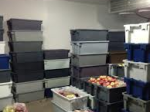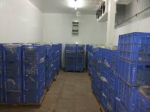Cold Storage
Background of the business : iThe centers of global growth are decidedly shifting to emerging economies, especially India, as the nation is moving forward at a phenomenal pace. It is a rarity that a country which has all along been considered as developing economy, should emerge as one of the principal drivers of the world's economy India is one of the fastest growing economies in the world, owing to stupendous domestic consumption, Stable regulatory policies and sustained government focus on economic reforms and deregulation.


However, in order to sustain this economic growth, the country needs a total resurgence in infrastructure creation. The country's policy maker have identified and tapped investment form the private sector in key areas of infrastructure like commuication, transportation, power and food preservation industry. Thay have also realized that high-tech cold storages are need of the hour. So cold storages have been given infrastructure status in 2011-12 Central Budgets. This has become an annual ritual now, with additional budget sops reminding us every year how important the entire cold chain sector is, and why it needs to be nurtured, if we aim to feed our millions in the coming years without having to resort to large scale import of food products.
India has emerged as a major producer of grains, fruits and vegetables in the World due to Joint efforts of Goverment agencies, farmers, R & D constitutions, use of technology, potential of being the biggest with the food and agriculstural sector. With 10 % of world production of fruits, India stands ranks first in spite of this per capita availability of fruits is quite low because of post harvest losses which account for 25% to 30% of total production, Besides, quality of sizable quantity of production deteriorates by the time it reaches the consumer. Because of perishable nature of the product, the farmers are being forced to sell their production immediately after harvest which results in glut situations and low price realization. This is where the Food preservation/cold chain sector comes into play. It plays a vital role in improving the value additional opportunities and creating surplus food for agro-food products.
Given the size of the industry and the nascent development satage, the food preservation sector is a key focus area for the goverment of India. The important of the sectoris further enhanced by fact that over 70 percent of the population depends upon agricultural activity for livelihood. The goverment has therefore been focusing on commercialization and value addition to agricultural produce, minimizing pre/post harvest wastage, generating employment and export growth in his sector, through a number of regulatory and fiscal incentives. The industry is largely unorganized, with a small but growing organized sector.
PRODUCTS & USERS
TECHNOLOGY/PROCESS FOR STORAGE OF DIFFERENT COMMODITY
Onion cold storage system is used in many countries of the word. Storage of union means controlling respiratory system in such a way that there is no formation of dead cell in the vegetable of formation of dead cell is very negligible. Generally onion can stored for 4 months without any deterioration at the temperature 0-1 degree C, with R.H. 65-70 %. The main objective in storage after harvest is to control the ripening to extend the marketing period.
Onion should not be unless adequately dried either in the field or by artificial means. It is necessary to dry the neck tissue and scales until they rustle when handled, otherwise the bulbs will rot in storage.
In early period of time, storage are only made to control temperature within the room, this restrict the type of storage of goods and its self life. Only non respirated material is used to store. This also deteriorates the quality of product in long term storage. The losses are very high due to insufficient air circulation and control of other parameters.
Now storage are built to store highly perishable fruits like apples, peru, onions, garlic which required to control parameter like temperature, carbon dioxide level, ethylene concentration, humidity and other parameters.
The adopting very advance technology for cold storage including modified atmosphere control machinery to control carbon dioxide concentration, humidity, international air circulation, reheating system to store product in term span.
Sprouting in onion is controlled by lower temperature. The temperature between 10-25 C increases sprouting. Rooting is influenced by relative humidity (RH) . More the relative humidity more is rooting. For effective long storage of onion storage of onion cold storage the parameters essential to be looked after are the bulb size, choice of cultivars, cultivation practices. Time of harvest, field curing, removal of tops, drying, packing, storage condition, optimum storage range of relative humidity 65% to 70% with the temperature ranging between 0 C to 1 C.
Controlled atmospheres in Cold storages
Reducing the level of oxygen in the atmosphere of a cold storage of a cold storage (either with or without increasing the level of carbon dioxide) can extend the life of the crop. It shows down spoilage, destroys insect and prevents mould growth without the need for treatment with toxic fumigants. However, different types of crops, and even different cultivars of the same species, require different atmospheres for successful storage, and each therefore needs to be independently assessed.
If the oxygen concentration is too low, it can produce off-flavors or discoloration in some type of fruits and vegetables. But the main disadvantages of controlling the cold storages atmosphere are economic the costs of setting up a controlled atmosphere sore and the cost of monitoring the gas composition are both high (twice those of normal cold storage) unless high-value, short season crops are stored, which substantially increase in price out of season, it may be difficult to justify the additional costs. Also the has to be fully used by a single crop, because of the different gas compositions required by different crops, and there may be competition from other producing area that have different harvest seasons. For these reasons, it is unlikely that controlled atmosphere cold storage will be suitable for producers in developing countries.
When operating at the correct temperature and optimum condition for particular crop, cold storage times, incorrect temperatures and damage to crops can cause significant changes, including browning, wilting and weight loss due to evaporation of water from crops. Losses f vitamin C in fruits and vegetable depend on temperature management after harvest. Losses are accelerated by higher storage temperatures and longer storage times, and condition that cause moisture loss after harvest, especially in leafy vegetables. Losses are also accelerated by brushing and other injuries and excessive trimming.
Pellet storage system
Normally, in India onion is stored & packed in gunny bags or nowadays it’s stored in leno bags of 50 kg each. This method does not permit through air circulation. This results in deterioration of products. Normally, 10 to 12 high of bags is stacked in storage resultant in overweight on lowest bag. With this types of packing methods, labors also increase.
Where in, following are distinct advantages of pallet storage system:
Fully mechanized material handling is possible through use of stackers.
Each pallet is stacked over to another pallet, resulting in uniform load distribution to product. This reduces the chances of damages of product.
Pallet system also provides uniform air distribution system within the product the product resulting in better quality of stored product.
Pallet storage system also eliminates use of intermediate steel structure for flooring. This also reduces the steel cost.
Extent of storage losses
The onion bulbs are generally stored from May to November for a period of four to six months. However, 50-90 percent storage losses are recorded depending upon genotype and storage conditions. The total storage losses are comprised of physiological loss in weight (PLW) i.e. moisture loss and shrinkage (30-40%), rotting (20-30%) and sprouting (20-40%). The (PLW) can be minimized by harvesting at right time, proper curing of onion bulbs and subsequent storage at desired temperature and humidity conditions.
Generally the rutting losses are at peak in initial months of storage, particularly in June and July, when high temperature couple with high humidity result the losses. However proper grading and selection of quality bulbs and good ventilation conditions can reduce the rotting losses. Application of post harvest fungicidal sprays can also reduce the rotting. But this is not a practice in India. Sprouting losses are humid air. Noticeable sporting losses are observed because of storage of proof quality bulbs having less and dormant period in dark red and white onion cultivars than the light red onion cultivars.
STORAGE OF APPLES
The onion bulbs are generally stored from May to November for a period of four to six months. However, 50-90 percent storage losses are recorded depending upon genotype and storage conditions. The total storage losses are comprised of physiological loss in weight (PLW) i.e. moisture loss and shrinkage (30-40%), rotting (20-30%) and sprouting (20-40%). The (PLW) can be minimized by harvesting at right time, proper curing of onion bulbs and subsequent storage at desired temperature and humidity conditions.